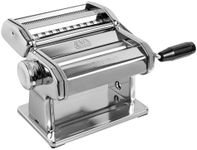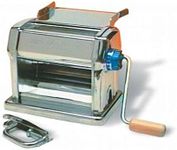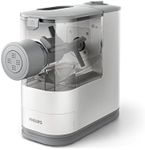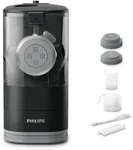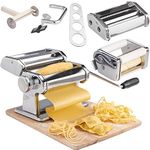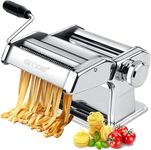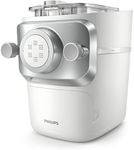Buying Guide for the Best Pasta Makers
Choosing the right pasta maker can greatly enhance your culinary experience, allowing you to create fresh, homemade pasta with ease. When selecting a pasta maker, consider the type of pasta you want to make, the frequency of use, and the level of convenience you desire. There are manual and electric pasta makers, each with its own set of features and benefits. Understanding the key specifications will help you make an informed decision that suits your cooking style and needs.Type (Manual vs. Electric)The type of pasta maker is a fundamental choice. Manual pasta makers require you to roll the dough through the machine using a hand crank, which can be more labor-intensive but offers greater control over the thickness and texture of the pasta. They are ideal for those who enjoy a hands-on approach and have the time to dedicate to pasta making. Electric pasta makers automate the process, making it quicker and easier to produce pasta with minimal effort. They are suitable for those who want convenience and speed, especially if you plan to make pasta frequently.
MaterialThe material of a pasta maker affects its durability and ease of cleaning. Stainless steel is a popular choice for its robustness and resistance to rust, making it a long-lasting option. It is also easy to clean and maintain. Plastic components, often found in electric models, can be lighter and easier to handle but may not be as durable. Consider how often you will use the pasta maker and how much wear and tear it will endure when choosing the material.
Pasta Types and AttachmentsDifferent pasta makers come with various attachments that allow you to make different types of pasta, such as spaghetti, fettuccine, or lasagna sheets. Some models offer a wide range of attachments, providing versatility in the types of pasta you can create. If you enjoy experimenting with different pasta shapes, look for a model with multiple attachments. If you have a specific type of pasta you prefer, ensure the machine can accommodate that style.
Ease of UseEase of use is an important consideration, especially if you are new to pasta making. Manual pasta makers require more skill and effort, while electric models are generally more user-friendly. Look for features such as clear instructions, easy assembly, and straightforward operation. If you value simplicity and want to avoid a steep learning curve, an electric model might be more suitable.
Cleaning and MaintenanceCleaning and maintenance are crucial for keeping your pasta maker in good condition. Some models have removable parts that are dishwasher safe, making cleaning easier. Manual models may require more effort to clean, as dough can get stuck in the rollers. Consider how much time you are willing to spend on cleaning and whether you prefer a model that offers easy maintenance features.
Size and StorageThe size of the pasta maker can impact where you store it and how often you use it. Larger models may offer more features but require more counter space and storage room. If you have limited kitchen space, consider a compact model that can be easily stored away when not in use. Think about your kitchen layout and storage options when choosing the size of your pasta maker.

